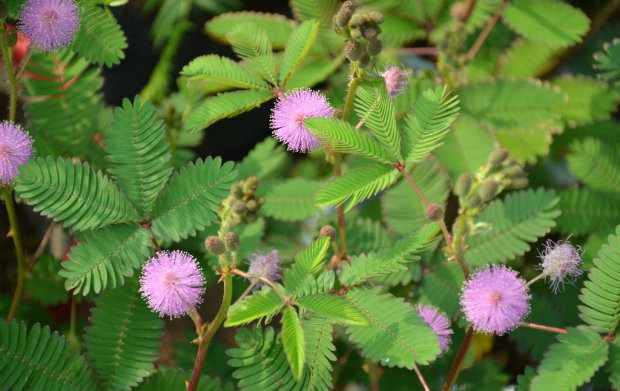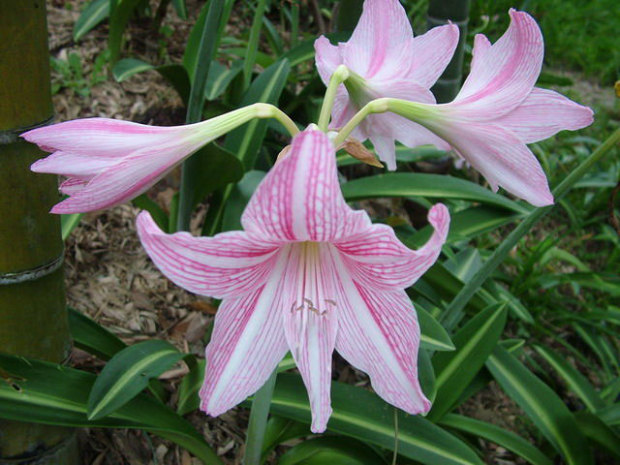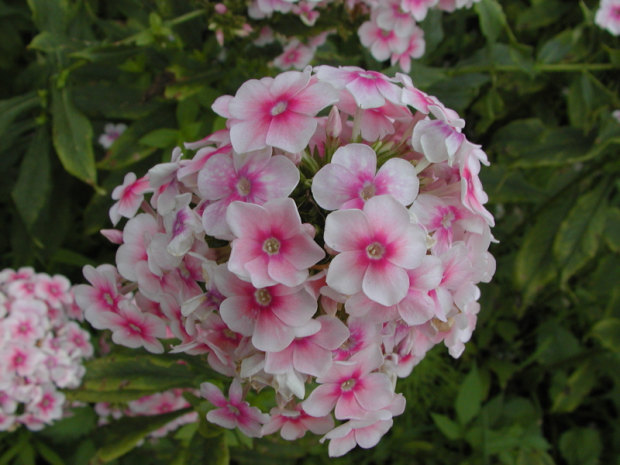Cultivation and culture methods of mimosa
Mimosa is also called fear of ugliness and mimosa. It is one of the plants that people are most interested in. Its leaves are very sensitive to stimuli, people gently touch the small leaves with their fingers and immediately close them "shyly", then the whole leaves hang down again, and after a while, the leaves gradually return to their original state. This special ability of mimosa is an adaptation to external adverse environmental conditions for a long time. It turns out that in tropical South America, the origin of mimosa, there are often strong winds and heavy rains. whenever the wind and rain comes, when the first drop of rain hits the leaves, the leaflets close and the petioles droop, thus avoiding or mitigating the damage caused by the storm.

Mimosa is a perennial semi-shrubby herb, which is commonly seen as a weed in the fields of South and Southwest China, but it is used as a pot plant in the north for viewing. Mimosa has strong habits and rapid growth, and is not strict with the soil. Potted plants require warm, humid and sunny conditions. The growing season can be placed on the balcony or in the yard. Winter should be moved to the indoor windowsill, the indoor temperature is about 10 degrees can safely pass the winter. The aged mimosa, which has been cultivated for many years, is not sensitive to external stimuli, so it is often cultivated as 1-2-year-old herbs and seedlings are cultivated every year for replacement. The propagation of mimosa is very easy to use the sowing method, but it can be sowed indoors in early spring. Soaking the seeds in warm water for one day and night before sowing can promote early germination. Under the room temperature of 15 ~ 20 degrees Celsius, seedlings can emerge after pot sowing for a week, and the seedlings can be planted once. The cultivation and cultivation of mimosa, also known as mimosa, shy mimosa. It is a perennial herb of Leguminosae, cultivated as a 1-2-year plant. 20-60 cm high, stem self-supporting with needles and fine hairs, leaves alternate, 2-3 pinnately compound leaves, born at the apex of the total petiole. Its head is 2-3 axillary. The pollen is red, hairy in appearance, with 4 petals and blossoms from July to September. Leaflets pinnately compound, 2-4 pieces, palmately arranged, 14-18 leaflets.
Mimosa has a prominent feature is that its leaves are extremely sensitive, can do vibration-sensing exercise, gently touch with the hand, the leaflets immediately merge left and right; touch heavier, even the petiole of the pinna is 60 degrees below. The same dormancy drooping at night, and the same response to sudden cold or electric stimulation, this morphological response is extremely interesting and seems to be shy, so it is called mimosa (this reaction is extremely sensitive in the evening). It is said that this is due to the fact that shy grasslands are produced in the deserts of South America, where there are often strong winds and heavy rains. when the storm comes, the leaves close and droop, which can reduce the harm of broken plants, which is an adaptive physiological response to the harsh environment in order to survive. Mimosa prefers warm, humid and sunny environment, suitable for sandy loam with good drainage and rich organic matter, strong plant, rapid growth and strong adaptability. Breeding is relatively easy, generally using the sowing method. Sowing can be done all the year round, but it is best to sow in the pot in early spring and February. Mimosa seeds mature late, in order to harvest seeds, must be sown in early spring, so that the seeds can mature before the early frost. In order to promote early germination, it is appropriate to soak the seeds in warm water of 30 degrees for one day before sowing; after sowing, put the pot in the environment of 15-20 degrees, and the seedlings can emerge in about 10 days. When the seedlings grow to 5-6 cm high, they are planted (with soil balls), and when they reach more than 10 cm, they are planted in a larger basin. During the plant growth period, it can be combined with watering, and the rotten dilute liquid fertilizer is applied (3-4) times every 10 days or so. As a potted ornamental flower, it is easy to move into the sunny place indoors and can survive the winter safely at a room temperature of 0-12 degrees. [plant cultivation] Culture methods of mimosa
The flowers and leaves of mimosa are of great ornamental value. Nowadays, many people like to raise potted plants at home, and mimosa is a good choice. Many people like mimosa, but many people can't grow it. So how much do you know about the culture method of mimosa? let's take a look at it with the editor.
The growing environment of a mimosa
Mimosa has strong adaptability, it likes warm and humid places, it grows well in moist and fertile soil, at the same time, it is not strict with the soil, is not cold-resistant, likes light, and can withstand semi-shade, so it is now doing more ornamental plant cultivation in the family. Mimosa is generally born in hillside jungles and roadside tidal wetlands.
The Culture method of Mimosa
Mimosa can be cultivated in ordinary soil, but it is best in loose, fertile soil. It doesn't need much fertilizer during its growing period. It is OK to apply dilute liquid fertilizer for 2 or 3 times when applying fertilizer, not too much fertilizer. Do not be an apprentice, because mimosa is mainly an interesting foliage flower, small is better. The planting technique of mimosa is relatively simple and the management is extensive. The requirements of climate, sunshine and soil are not strict. I like a warm and humid environment.
Planting methods of three mimosa
Mimosa is generally propagated by sowing, and the sowing time is from late March to early April. Spread the seeds evenly on the fine soil and cover the soil about 1.5cm. When the temperature is about 18 ℃, the seedlings can emerge in about 10 days. When mimosa is managed in the field, when the distance between the planting plants is 25cm and 30cm, it is necessary to loosen the soil, hoe and water in time, and when potted indoors, water it every three days in summer.
Maintenance of mimosa
During the growth period, mimosa can be irrigated with rotten dilute liquid fertilizer every 10 days or so. When mimosa is transplanted indoors when potted ornamental flowers, it is best to move into the sunny place indoors. At the same time, mimosa likes to be moist. It is watered once a day in summer, and the soil is required to be deep, fertile and moist. Moreover, mimosa is a cold-resistant plant. The indoor temperature should be 18 degrees in winter, or it will die on its own.
- Prev

Cultivation and Culture methods of Zhu Dinghong
On Zhu Dinghong's large, globular bulb, there are 8 flattened and slightly fleshy leaves, which are drawn out at the same time or after flowering, and there are stout and hollow flower stems in the leaves, which are similar to lilies, while there are 6 bright-colored funnel-shaped flowers in white, red, or white and red.
- Next

Culture and cultivation management methods of Fulukao
The hydrangea flowers are in full bloom and the summer flowers are in full bloom to welcome the autumn, which is the charm of the peach blossom season cultivated in the courtyard in our country. It is a perennial perennial herbaceous flower, so it is also called perennial root Fluke. The height of the plant is about 50ml / 80cm and the diameter of the floret is about 2.
Related
- Fuxing push coffee new agricultural production and marketing class: lack of small-scale processing plants
- Jujube rice field leisure farm deep ploughing Yilan for five years to create a space for organic food and play
- Nongyu Farm-A trial of organic papaya for brave women with advanced technology
- Four points for attention in the prevention and control of diseases and insect pests of edible fungi
- How to add nutrient solution to Edible Fungi
- Is there any good way to control edible fungus mites?
- Open Inoculation Technology of Edible Fungi
- Is there any clever way to use fertilizer for edible fungus in winter?
- What agents are used to kill the pathogens of edible fungi in the mushroom shed?
- Rapid drying of Edible Fungi

